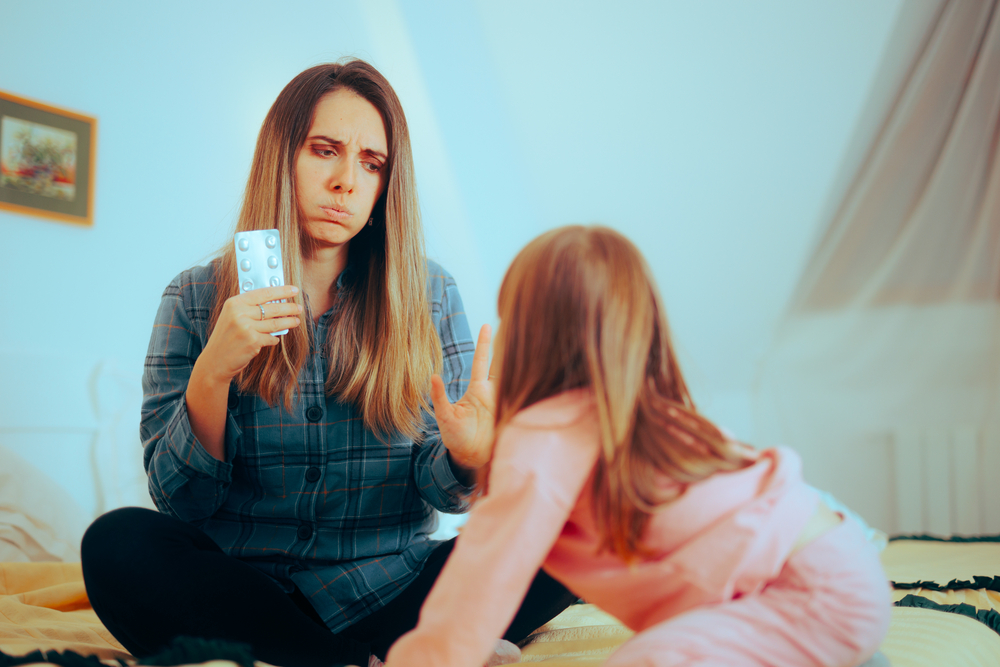In May, the FDA expanded the approval of pharma giant AbbVie’s SSRI escitalopram (Lexapro) to include kids ages seven and up who have anxiety. The basis for the approval was a clinical trial conducted by AbbVie employees, with an article written by AbbVie’s ghostwriting firm.
The researchers randomly assigned 275 kids aged 7-17 with a diagnosis of generalized anxiety disorder (GAD) to either receive Lexapro or a placebo. The trial lasted for eight weeks.
The findings were mixed. On the 30-point PARS-GAD anxiety measure, there was a mean difference of 1.42 points between the drug and placebo group (statistically significant at p <0.05, but not significant at p <0.01). This is the finding that supports the FDA’s approval.
However, the researchers also found that there was no difference between groups in response to the drug, remission from anxiety, and overall functioning. That is, about the same number of kids, whether on the drug or on placebo, experienced clinical improvement (“response”) or no longer had anxiety (“remission”). Nor did the drug improve overall functioning.
Concerningly, Lexapro also increased suicidality sixfold. In the escitalopram group, 9.5% of the kids became suicidal—compared with 1.5% in the placebo group. One patient actually attempted suicide in the escitalopram group (versus none in the placebo group).
This is especially notable since having a depression diagnosis or suicidal ideation were exclusion criteria for the study, meaning that the kids were not depressed or suicidal when they started the drug trial.
The researchers’ conclusions? Despite the same number of kids improving whether they received the drug or placebo and suicidality increasing sixfold in those who took the drug, they write:
“This large multicenter trial replicates earlier studies demonstrating the efficacy of escitalopram in adolescents with GAD and extends these findings to children aged 7–11 years. In addition, the study suggests that escitalopram is generally well tolerated in children and adolescents.”
 SSRIs (like Lexapro), despite often being prescribed for people at risk of suicide, have been repeatedly shown to increase suicide risk, particularly for children and adolescents. That’s why the FDA has required a “black box warning” on SSRIs to let consumers know that the drugs make kids and teens suicidal.
SSRIs (like Lexapro), despite often being prescribed for people at risk of suicide, have been repeatedly shown to increase suicide risk, particularly for children and adolescents. That’s why the FDA has required a “black box warning” on SSRIs to let consumers know that the drugs make kids and teens suicidal.
Forest Labs (which was since bought by Allergan, which then merged with AbbVie) paid $313 million in 2010 for obstruction of justice, illegal marketing, kickbacks, and false insurance claims related to Lexapro and other drugs.
Among other controversies, AbbVie was forced to pay $24 million in 2018 and another $25 million in 2020 to settle lawsuits about illegal kickback practices and illegal marketing for its various drugs. Additionally, Allergan was one of the main firms accused of creating the opioid crisis by illegally marketing opioids. Last year, AbbVie agreed to pay $2.37 billion to settle these allegations.
The current study was published in the Journal of Child and Adolescent Psychopharmacology. Like most published reports of clinical trials of drugs today, the pharmaceutical company’s own employees were listed as authors, and it paid a medical writing company, Prescott Medical Communications Group, to write the article. Indeed, AbbVie made it clear that it controlled all aspects of the trial, writing that it “funded this study and participated in the study design, research, analysis, data collection, interpretation of data, and reviewing and approval of publication.”
The first author was Jeffrey R. Strawn at the University of Cincinnati Medical Center. While he is not an employee of AbbVie or the companies AbbVie paid to conduct the study, the paper’s disclosures state he has received research funds from Abbvie.
Authors Edward Greenberg, Chengcheng Liu, and Mallika Gopalkrishnan are direct AbbVie employees. Authors Leslie Moldauer, Rebekah D. Hahn, Alexandria Wise, Kristina Bertzos, and Beth Eisenberg are all employees of Syneos Health, a company funded by AbbVie to conduct the study. James A. Knutson, the paper’s last author, owns Core Clinical Research, another such company. Author Molly McVoy received a grant from The Hartwell Foundation, which focuses on expanding biomedical interventions in children.
Carol Brown, the Prescott Medical Communications employee who wrote the article, is not listed as an author. As is now usual for such “ghost authors,” she is instead acknowledged for her “writing and editorial assistance.”
It’s usually required for an article to specify what work each individual listed author did on the study and the article writing. Here’s that paragraph in this study:
“All authors contributed to the interpretation of data and provided critical reviews of all article drafts.”
As can be seen by this acknowledgment, there is no assertion that the named authors designed and conducted the study or that they wrote the article. The published article is AbbVie’s report of its trial, and not surprisingly, the article draws a conclusion that escitalopram is safe and effective in children, even though—in the same article—the published data tells of a drug treatment that is ineffective in children and increases the likelihood they will become suicidal. It is, of course, the conclusion that AbbVie will now use to market escitalopram for use in children.
****
Strawn, J. R., Moldauer, L., Hahn, R. D., Wise, A., Bertzos, K., Eisenberg, B., & Knutson, J. A. (2023). A multicenter double-blind, placebo-controlled trial of escitalopram in children and adolescents with generalized anxiety disorder. Journal of Child and Adolescent Psychopharmacology, 33(3), 91-100. http://doi.org/10.1089/cap.2023.0004 (Link)















Business as usual … big Pharma needs to be broken up … it’s absolutely corrupted itself, with it’s unchecked and undeserved power.
Report comment
Another wonder drug hits the streets, and the populace is wondering why it’s useful. That’s why it’s a wonder drug.
Report comment
The even bigger problem is the FDA’s approval of the drug for children. Seems like the FDA is nothing but a rubber stamp agency. Really tragic. Thank you, Peter, for your clear and thoughtful writing on this important issue.
Report comment
The FDA approval is a travesty because the data don’t support use of the drug in children. But I don’t believe the fact that the article was “ghostwritten” is a concern.
I have worked for pharmaceutical companies and have written clinical study reports. There was always a company team that scrutinized every word of the report and made sure the drug was made to look as good as possible.
Listing the Prescott Medical Communications employee who wrote the article as providing writing and editorial assistance is probably accurate.
Report comment
There has never been any literature supporting the use of antidepressants in children, except one study on prozac and adolescents, and that one was critiqued heavily for many flaws. It amazes me that psychiatrists are allowed to prescribe it. It’s malpractice.
Report comment
I agree with you.
Report comment
Yeah. And the self harm risk from SSRI went, if I’m remembering correctly, from “statistically no different that control’s” to twice as in controls, to four times as control’s, to now, 6 times as control’s?.
And funny, in my case, I’ve never been diagnosed with depression, but I did have conjuntivitis from a systemic disease that takes decades to be diagnosed when I was a kid, and just the tearing does make you feel sad, like a reflex, in my personal non professional opinion.
That could be missdiagnosed, to my mind, as “sadness” “out of nowhere”, just like tickling or watching someone smile makes you happy, like a reflex, like Duran Duran would have said.
And given hypersensitivy, not necessarily allergies that are actually a different thing, the frst is a broader phenomena, I can imagine the number of misdiagnoses, even with allergy diagnostic inflation. Not giving a professional opinion, just a personal one from lived experience.
Report comment
I was prescribed antidepressants as an adolescent. All they ever did was make me overweight! This caused body issues and MORE depression.
Report comment
If you want to understand SSRI usage in children read ‘Children of the Cure’ by David Healy.
Why is it not fraud for a doctor to claim a drug relieves depression when the data says it doesn’t? It seems like making false claims for personal benefit and in most situations it’s a crime.
Report comment
If I am remembering correctly one of those APA guidelines actually in one paragraph cautions againts it’s use, and in 2 following paragraphs advises on how to use SSRIs in kids. Very typical in guidelines these days, if I’m remebering correctly. Like in say two different things and let the reader, if he or she is not careful enough, to pick one.
And courts defer to the FDA on technical matters, and the FDA defers to practitioners since they “know the patient” and are “experts”, and patients when harmed have to go against the current to prove “damages” which in medicine, in my personal non professional experience, are “stocastical”, not sutitable to a strict causation model, unlike other kind of personal injuries. 🙁
They can even be idiosyncratic, meaning, somehow, unexpected and unpredictable.
Even If remember correctly, the forensic medicine textbooks weren’t really “evidence based”. they had this classification of “no injury”, less than 7 days to recover, 7-21 days, more than 3 wks, more than 3 months, etc. Which in these pharmacological cases is not apt, since causation is very hard to prove, to my mind.
Which is why I think a “strict liability” kinda insurance is more to the task, so that the insurance company actually stops paying for those kind of medications that actually produce harm in the whole insured population. How would that work when insurance companies have their money invested in pharma and hmo’s, I dunno, but at least for damage mitigation might work…
I fantasized that some of them, the insurers, actually stopped covering psychiatric care precisely because it actually increased costs in the “long run”, long enough for the insurance to kick in. I fantasized an adult, the household earner, like in hundreds of thousands income per year, getting diagnosed with depression, then added a benzo, labeled bipolar, the “typical” course described in many person’s narratives here, but, with the twist that he had life insurance that wen’t to be payed in case of decease, only to find out, that the particular case was not to be paid, precisely because it was self harm, probably induced by medication.
I especulate not may kids before being prescribed SSRIs are life insured. And, even if they were, would the insurance cover it as a severe fatal side effect of treatment when it involved self harm?.
Maybe, I kept fantasizing, not a factual statement, that’s why they increased the bipolar diagnoses in kids? So that the neuroleptics are used more frequently and might actually decrease/mitigate the risk of self harm among kids. There might be, fantasizing of course, not being factual here, method in the madness of the diagnostic categories and their evolution…
Creepy, I admit. Creepier still if some OTHER company actually offered to the insurer to pay the insurance in case of life loss in full, just to keep everything “quiet”.
My novel writing mind actually popped the control setting to test such hypothesis: Ask an insurance company to cover ANY know adverse drug reaction from psychotropic medications BEFORE being used on the, hopefully, to be insured and psychiatrically treated, and see HOW MUCH the insurer put a price on it. Something like being THE big kahuna of a company going skydiving or snowskiing, or fighting on a wrestly match, just let insurers put a price on it, see what their now unrefusable price quote for that risk would be…
Report comment
Reformulating:
What if I go to an insurer and ask for an insurance against ANY know adverse drug reactions because of psychiatric or psychological diagnosis and treatment? What would they charge me for such insurance, and how much they would pay me or my dependents if I get a severe crippling side effect, with no questions asked if it was my fault or the docs fault, the FDA’s fault or the pharma’s fault?. Just enough if it’s published as a ADR? Like they cover most “medical” diseases.
What if I buy a very comprehensive insurance with lots and lots of lawsuits in case I am treated against my will? Ohhh!, I’ll pay lots and lots for that, even if I, unfortunatly pass away, to be donated to a worthy cause of my choosing. I imagine that Amnesty Internationl would be very interested if there’s a lot of money and things “don’t look ok” upon the refusal to pay them. What about the ACLU?.
Would any reasonable insurer sell me one of those? Why not? Among some of us survivors they would make a small fortune if treated against our will, and if we get harmed by it. Or both!. Heck!, I would even use an ankle bracelet in case I get kidnapped into the big hospital where my previous, I assume, MD kidnapper is now a director!. Maybe a swat team might be sent BEFORE I get the “chair”, giving my, I assume multiple heart conditions…
I could ask for the extraspecial coverage for ECT or depot neuroleptics. SSRI induced akathisia?, no prob, just pay a “smaill” premium and you are covered. They might even get an emergency court order just to get me out before that happens…
What if I pass away and my insurance, because of the lawsuits gets to test my hair, nails, bone, eye fluid to see if no one ever medicated me covertly, without my knowledge and consent?. I’ll even agree to pee in a cup every week for the rest of my life (like in Gattaca), just to get that kind of a coverage, of course, to be donated to a worthy cause of MY choosing in case I pass away or get severely incapacitated by that.
I’ll even tatoo both my buttocks, both my arms and everywhere, even both my temporal regions with my insurance policy number and the phone with a legend: Before applying ANY treatment please contact: yarayarayara. ELSE SEVERE PUNISHING DAMAGES MIGHT APPLY, if that would get the job done.
Talk about affective altruism.
That’s how, I think, fantasizing, not being factual, I would actually price things, benefits, side effects, ADR, whatyamacallit. By taking them out of the EXTERNALITY universe of postkeynesian economics.
Fantasy, what a thing…
If YOU are an insurance company interested in providing such coverage for me, or anyone else, you know where to put the add…
Report comment
From https://www.forbes.com/advisor/legal/personal-injury/economic-damages/
From https://www.forbes.com/advisor/legal/personal-injury/non-economic-damages/
From https://www.facs.org/advocacy/federal-legislation/liability/guide-to-liability-reform/ending-the-confusion/
If I am understanding correctly, as Colbert would probably said: I would be very suprised, but! if an insurance company had to pay me accurately the cost to me of ANY or the AVERAGE malpractice lawsuit, the cost of medical care would be unaffordable for EVERYONE, by extension, as in I am the same as anyone and probably everyone else, ceteris paribus, all else being equal, mutatis mutandis, changing that has to be changed. Taking into account that only about 30% such lawsuits actually “proceed”, or are not discarded…
That to my unenlightened non economist opinion means damages by malpractice of medicine are actually uninsurable, in effect (as in the point, the effect they are SUPPOSED to have, is to FULLY compensate the victim, from the victims perspective I assume tacitly), because they are way too expensive to be actually paid in full. The non-economic damages are “capped”. Considering that the “average” payout for such favorable to the claimant rulings are 5 to 8 million dollars, as stated in the link above. A surgeon makes, if I remember correctly around 250,000 to 400,000 US dlls per year. That on the top scale is 20 yrs of actual, not trainee, surgeon work, for every damaged patient, on the top of both scales. Assuming him or her pays his full earnings before taxes, etc…
So, a damaged sufferer actually gets payed less (way less?) than the damages actually cost, on average.
In general, not in psychiatry.
So, I dare all economists that write textbooks and earned, or being awarded a Nobel Memorial Economics prize to put a “white paper” on the REAL costs, benefits and damages of medical practice, malpractice, whatever, I guess both?!. Considering my ignorance and the fact to me, as my opinion, that it looks like a classical externality that get’s paid almost in full by the victim, and other humans that actualy care and can contribute for him or her. Since it is the victim, and carers (they suffer too you know, and as Chicolini would have said: “That runs into money!”), not only caretakers, and the social care system, assuming there is one, that picks up the unpaid tab.
That’s one among other reasons I gave up practicing medicine, to my mind, even with the best of my care, probably some patients might have been damaged and there was no way on heaven, earth or hell, god forbids, for them to be actually properly compensated, and it was inmoral for me to do a job that actually brought them little benefit, for a pay that was nowhere near the damages that on the aggreate I could have caused or contributed even if only a “small” part of a medical team.
Considering the fraud, misrepresentation, improper statistical tests, damages capping, unfair judicial and legal system, etc.
I betted, to my alter ego, that not even with a Supreme Court ruling, or Congressional subpoena I would get ALL the evidence that was supposed to be collected at an average clinical trial, redo the analysis, etc., of course assuming I could actually do that, as in being THAT competent. BEFORE I got to actually see a patient in the office.
And I bet, I was and I am not alone in that “feeling”…
Some cartoon might actually put a Banner on top of some egregious/recurrents in the malpractice professional lifespan: “You Will No Get Properly Compensated if You Get Damaged by Whatever Goes on in This Office or Building”.
Hey even the rose big feline might follow around some such professionals with such a banner, as in way back then IT used to do that, when some people, no fault of their own, couldn’t pay the money they owed. Maybe some insurers ought to look into that as cost minimizing strategy, just kidding :P, not a real suggestion, neither of what I wrote. Except for the economists..
Report comment